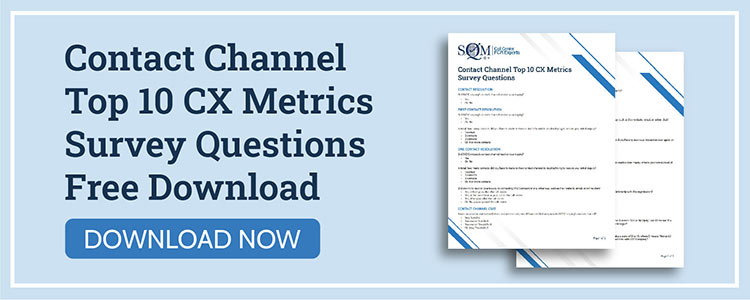Customer Expectations Using Contact Channels
Today's connected customers expect to resolve their inquiry or problem on the first contact effortlessly, regardless of what contact channel (e.g., website, call center, IVR, Chat, and email) they choose to use. In fact, in the vast majority of cases, customers expect to resolve their inquiry or problem in one contact regardless of the contact channel they choose to use or the complexity of the inquiry or problem.

SQM research shows that 93% of customers using the call center channel and 72% of customers using the website channel expect to resolve their inquiry or problem in one contact. However, customers' expectations to resolve any inquiry or problem on the first contact using any contact channel they choose is challenging for organizations to meet.
There is much debate on the best cx metrics for measuring, benchmarking, and improving a contact channel and/or an omni-channel customer experience (CX) for resolving an inquiry or problem.
Many contact center managers think internal metrics such as web analytics, service level, hold time, call transfer, call length, channel completion rate, repeat contact, and quality assurance are essential for improving CX. Interestingly, the above internal metrics are used more commonly than the external Voice of the Customer (VoC) survey metrics to improve CX.
SQM agrees that these internal metrics can help improve CX, but the metrics that matter the most for improving CX for resolving an inquiry or problem are the external VoC survey metrics. After all, the customer should be the judge of their own experience.
Most organizations measure CX at the enterprise level and the call center channel using a customer survey process. However, in most cases, organizations conduct limited or no surveys for measuring customers' experiences using other core contact channels (e.g., web self-service, IVR self-service, chat, email, omni-channel) to resolve an inquiry or problem.
It has been SQM's experience that organizations conducting post-contact surveys on customers' experiences trying to resolve an inquiry or problem are more likely to improve CX than organizations using only internal metrics. In fact, 70% of SQM clients improved One Contact Resolution (OCR), First Contact Resolution (FCR), and Customer Satisfaction (Csat) because they conducted post-contact customer surveys for core contact channels.
It is challenging to improve FCR and CX if an organization does not conduct surveys to measure and benchmark FCR and CX using core contact channels and omni-channel for resolving an inquiry or problem.
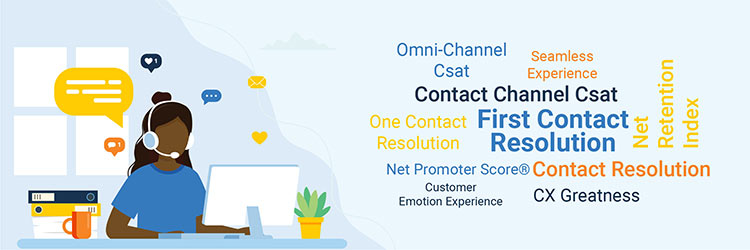
Top 10 Call Center Metrics
The Top 10 customer experience metrics apply to any industry and customer contact channels to resolve an inquiry or problem. The Top 10 CX Metrics are based on SQM's experience of measuring and benchmarking over 500 leading North American organizations and surveying over 5 million customers who used a contact channel. SQM has been conducting contact channel CX benchmarking studies since 1996.
SQM's Top 10 CX Metrics provides valuable insights on customers' experiences when using a contact channel or multiple contact channels to resolve an inquiry or problem and on an organization's overall customer relationship performance.
Figure 1 shows the definition for each Top 10 CX Metric. These metrics are split into three main areas: Contact Channel CX Metrics, Omni-Channel CX Metrics, and Enterprise-Wide CX Metrics. The contact channel CX metrics and omni-channel CX metrics are primarily used for measuring a customer's contact channel experience. Enterprise-wide CX metrics measure the customer relationship with an organization based on their contact channel CX.
Typically, enterprise-wide CX metrics are based on customer perception surveys. However, enterprise-wide CX metrics can also be based on post-contact customer transaction surveys. Using enterprise-wide CX metrics based on a customer's experience using a contact channel or omni-channel can provide valuable insights on how contact channels and omni-channel delivery is impacting the organizations' overall customer relationship, referrals, and retention.
Figure 1: Top 10 CX Metrics Definition
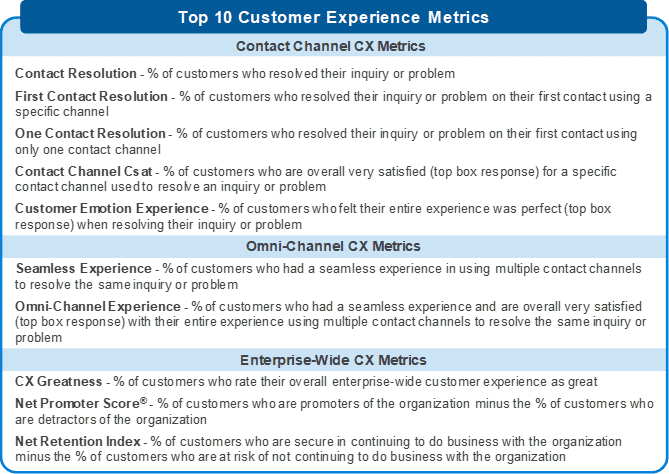
Call Center Metrics Benchmarking Data
The Benchmarking Data shown in the blog is for the call center channel.

Contact Resolution
Contact Resolution is based on a customer's inquiry or problem being resolved. It might take two or more contacts to be resolved, but it was resolved. The benchmark average for the contact resolution metric is 88% and a world-class standard is 95%. The majority of organizations do not know whether or not they resolved the customer's inquiry or problem. It is assumed that if the customer does not call back, their inquiry or problem is resolved. However, for unresolved contacts in the best-case scenario, it might be that the customer chooses to use a different channel to resolve their inquiry or problem. In the worst-case scenario, the customer may have gone to another organization. Therefore, it is essential to measure contact resolution by contact channel.
First Contact Resolution (FCR)
First Contact Resolution (FCR) is based on the percentage of customers who resolved their inquiry or problem on their first contact using a specific contact channel, such as a call center, web self-service, IVR self-service, email, or chat. FCR does not take into consideration whether or not other contact channels were used. The term 'contact' can be replaced with the specific contact channel (e.g., 'first call resolution, 'first email resolution,' 'first web self-service resolution,' or 'first IVR self-service resolution'). Many SQM clients consider FCR to be their most important CX metric for measuring and managing CX. The benchmark average for the FCR metric is 71% and a world-class standard is 80%. This means that nearly one-third of customers have to contact the contact center again to resolve their inquiry or problem, which, for most organizations, represents a considerable opportunity to improve.
One Contact Resolution (OCR)
One Contact Resolution (OCR) is based on a customer resolving their inquiry or problem on the first contact using only one contact channel. In other words, they were not having to use another contact channel before, during, or after using the single contact channel. The benchmark average for the OCR metric is 62% and a world-class standard is 75%. When you ask customers what is most important to them when they use a contact channel – a clear majority of them will say they want to resolve their inquiry or problem on the first contact using only one contact channel. Given that customers wish to have their inquiry or problem resolved on the first contact using one contact channel, the OCR metric is perfect for measuring whether or not the customer received that experience. An essential distinction between FCR and OCR is that FCR only considers using an individual contact channel. OCR factors in using multiple contact channels to resolve an inquiry or problem.
Contact Channel Csat
Contact Channel Csat is based on a customer's experience trying to resolve an inquiry or problem. The benchmark average for the contact channel Csat very satisfied (top box rating response) metric is 77% and a world-class standard is 85%. Csat has been the most widely used and understood CX metric of all the VoC metrics. Perhaps the popularity of Csat is because it has been used for many years. At SQM, we recommend measuring Csat at the individual contact channel level and the enterprise-wide level. SQM uses a 4-point satisfaction scale with "very satisfied" anchoring the highest point of the scale and "very dissatisfied" anchoring the lowest end of the scale. For Csat, SQM uses the top box response for benchmarking purposes because anything less than Csat top box response represents an opportunity for improvement.
Customer Emotional Experience (CEE)
Customer Emotional Experience (CEE) is based on the customers who felt their entire experience was perfect for resolving an inquiry or problem. At SQM, we use a 5-point customer emotional experience scale with "perfect" anchoring the highest point of the scale and "totally unacceptable" anchoring the lowest end of the scale. The benchmark average for the CEE perfect (top box rating response) metric is 39% and a world-class standard is 50%. For customers who described their emotional experience as perfect, the Net Promoter Score® was 79%. Clearly, providing customers with a perfect emotional experience has a substantial positive impact on customers' likelihood to recommend an organization to others.

SQM research shows that 37% of customers simultaneously use two or more contact channels to resolve the same inquiry or problem, and 20% of customers who used a call center did so because a self-service contact channel failed.
Furthermore, most North American organizations do not know how to measure CX for those customers who used two or more contact channels to resolve the same inquiry or problem. As a result, SQM is often asked, "What is the best way to measure CX for those customers who used two or more contact channels to resolve the same inquiry or problem?" We recommend using the seamless and omni-channel experience metrics.
Seamless Experience
Seamless Experience is based on a customer using multiple contact channels to resolve the same inquiry or problem, and it was a seamless experience. In other words, a seamless experience is when a customer uses two or more contact channels to resolve the same inquiry or problem and can pick up from where they left off in the previous channel without having to start over from the beginning. The benchmark average for the seamless experience metric is 51% and a world-class standard is 65%.
Omni-Channel Experience
Omni-Channel Experience is defined as the percentage of customers who are overall very satisfied (top box response) with their entire experience using multiple contact channels to resolve the same inquiry or problem. The benchmark average for the omni-channel Csat very satisfied (top box rating response) metric is 55% and a world-class standard is 65%. This low Csat experience percentage and high multi-channel usage for resolving the same inquiry or problem suggests that improving the omni-channel CX is critical.

Enterprise-Wide CX Metrics
Enterprise-Wide CX metrics are typically a global metric to describe the customer's enterprise-wide relationship with an organization. Typically, enterprise-wide CX metrics are measured using a perception survey method. However, it is not uncommon for enterprise-wide CX metrics to be measured using transaction surveys to understand how a customer's experience using a contact channel and/or omni-channel impacted their overall relationship with the organization.
CX Greatness
CX Greatness metric is based on a customer's contact channel experience and how they rate their overall relationship with the organization. For example, if a CX greatness rating is achieved, the customer would rate their overall relationship with the organization as "great," which is a top box rating response based on their contact channel experience. The benchmark average for the CX greatness (top box response) metric is 53% and a world-class standard is 65% for customers who used a contact channel. Based on CX using a contact channel, only 5% of SQM clients have a CX Greatness rating of 65% or higher, which we consider world-class performance. Many organizations are providing good CX but strive to deliver great CX at the world-class level. To go from good to great CX, it is essential to measure CX Greatness on an ongoing basis to understand performance trends and improvement opportunities. The CX Greatness metric is easy to communicate internally to executives and front-line staff and is a metric that people can rally behind.
Net Promoter Score® (NPS®)
Net Promoter Score® (NPS®) is widely used by many leading North American companies. In many cases, it is the most critical metric they use for measuring CX and understanding the impact that CX has on customers' likelihood to recommend the organization to others. The benchmark average for the transaction NPS® metric is 41% and a world-class standard is 55% for customers who used a contact channel. On average, contact centers' management groups manage or share ownership of six contact channels and, as a result, are responsible for CX on most, if not all interactions a customer has with an organization. Therefore, contact centers significantly impact customers referring the organization to others.
Net Retention Index (NRI)
Net Retention Index (NRI) is an important metric because it measures customers' likelihood to continue to do business with the organization. The benchmark average for the transaction NRI metric is 55% and a world-class standard is 65% for customers who used a contact channel. It has long been SQM's belief that customer retention should be one of the primary purposes of the contact center, especially when you consider that, in many cases, a contact center is the last line of defense to stop a customer from defecting. Customer retention means that customers are not leaving the organization as a result of their contact center experience. By retaining customers, the contact center protects the organization's greatest asset – its customers. Astonishingly, most contact center managers either have no idea, or do not measure, whether or not they have retained customers due to their contact center experience and, therefore, have no idea of the organization's resulting revenue loss. Unresolved contacts are a leading indicator of customers defecting to competitors. Furthermore, for the average contact center, with nearly one-third of customer contacts not being resolved on the first contact, it is no wonder that customers just want their contact resolved.
The Right CX Metrics
The Top 10 CX Metrics are not ranked in order of importance because they all provide valuable CX insights. However, there are pros and cons associated with each one of these metrics. For example, Net Promoter Score® (NPS®) is useful for understanding the company brand and a customer's willingness to recommend an organization. However, the NPS® metric is not as helpful in making contact channel CX improvements as other CX metrics.
Conversely, FCR focuses on whether or not a customer had their inquiry or problem resolved in one contact, which provides excellent insights into what CX improvements are needed. However, this CX metric does not represent the customer's entire enterprise-wide experience. Thus, NPS® offers unique insights into customer referrals, while FCR provides excellent insights into CX improvements.
There is much debate on the right metrics for measuring a customer's experience when using a contact channel or multiple contact channels for resolving an inquiry or problem and which metrics to focus on when measuring enterprise-wide CX performance.
Again, it is essential to emphasize that of these Top 10 CX Metrics, and there is no single metric that can measure all aspects of a customer's experience. Therefore, it is helpful to use all 10 or multiple metrics for measuring and managing CX.
Figure 2 illustrates the cascading perspective of the Top 10 CX Leading and Lagging Metrics. As shown, the leading CX metrics (i.e., contact resolution, FCR, OCR, Contact Channel Csat, Customer Emotion Experience, Seamless Experience, and Omni-Channel Experience) have an impact on the performance of the lagging CX metrics (i.e., CX Greatness, Net Promoter Score®, and Net Retention Index). Consequently, when leading CX metric performances are high or low, so too are the performances of the lagging CX metrics.
Figure 2: Top 10 CX Leading and Lagging Metrics
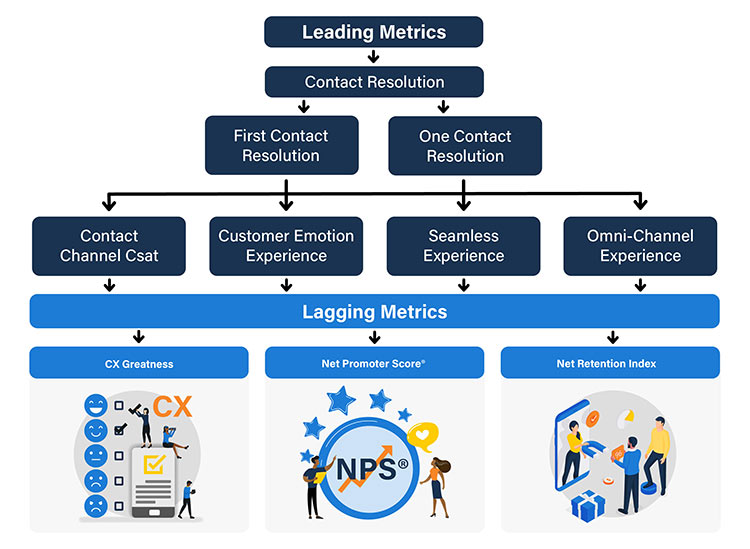
Top 10 CX Metrics World Class Performance Targets
SQM is often asked, "What are the world-class performance targets for the Top 10 CX Metrics?" The answer to this question is based on our top 5% best performing organizations for delivering world-class CX. The contact channel world-class CX performance targets apply to all core (e.g., call center, web self-service, IVR self-service, chat, email) contact channels. The following are the Top 10 CX Metrics world class performance targets:

Contact Channel CX Metrics:
- Contact Resolution is 95% or higher
- First Contact Resolution is 80% or higher
- One Contact Resolution is 75% or higher
- Contact Channel Csat (top box response) is 85% or higher
- Customer Emotion Experience (top box response) is 50% or higher
Omni-Channel CX Metrics:
- Seamless Experience is 65% or higher
- Omni-Channel Csat is 65% or higher
Enterprise-Wide CX Metrics:
- CX Greatness (top box "great" rating response) is 65% or higher
- Net Promoter Score® (NPS®) is 55% or higher<
- Net Retention Index (NRI) is 65% or higher
Note: Csat uses a 4-point scale, CX Greatness and Customer Emotion Experience use 5-point scales, Net Promoter Score® and Net Retention Index use 11-point scales
The Right Employee CX Accountability Metrics
Although many CX metrics provide valuable insights, SQM recommends using only a few metrics to create CX accountability from the Agent to the CEO level. Typical CX metrics used to create accountability are:
-
At the Agent level are Call Resolution, CEE, and Csat.
-
At the middle management level (e.g., supervisor, manager, director), typical metrics used to create accountability are FCR, OCR, CEE, and Csat.
-
At the senior management level (e.g., VP to CEO), standard metrics used to create accountability are FCR, OCR, Contact/Omni-Channel Csat, CX Greatness, Net Promoter Score®, and Net Retention Index.
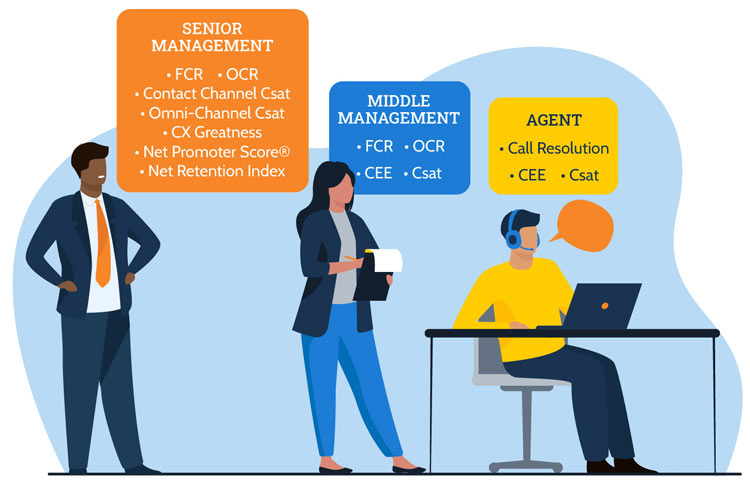
A common question asked of SQM is, "are the Top 10 CX Metrics and corresponding world-class performance targets only for contact centers that handle simple issues (e.g., retail)? Or can they also be used for contact centers that handle complex issues (e.g., insurance, healthcare, financial, or telco)?"
SQM's experience has shown that contact centers that handle complex contacts have achieved these world-class performance targets. In addition, customers do not judge their contact channel experience based on the complexity of the inquiry or problem; instead, they judge their experience based on whether or not their issue was resolved, preferably in the first channel used and in one contact. As a result, SQM believes that these targets apply to all contact centers, whether they handle simple or complex issues.
VoC Closed-Process CX Improvement Tips
Tips for using a VoC Closed-loop process for measuring and improving customers' experiences using contact channels for resolving an inquiry or problem are to:
- Conduct post-contact channel CX surveys within one business day of the customer's interaction. When a customer is surveyed within one business day, they can remember the experience and, in many cases, see it as a follow-up contact.
- Follow up with customers identified as dissatisfied and/or their contact was unresolved to determine how their inquiry could be resolved, as this is a golden opportunity to provide service recovery.
- Consistently measure core contact channels (e.g., call center, web self-service, IVR self-service, chat, email) on an ongoing and daily basis.
- Use a standard set of CX metrics (e.g., OCR, FCR, Csat) so that you can effectively compare how each contact channel is performing for resolving the same type of contact reasons.
- Evaluate customers' experiences who have used two or more contact channels to resolve the same inquiry or problem because these customers have historically had very low Csat.
- Ask customers an open-ended question as to why they could not resolve their inquiry or problem on the first contact channel using only one contact.
- Report CX survey data results weekly to all levels of management and monthly at the Agent level through customer service management software.
- Benchmark contact channels' CX performance within an organization against a specific industry, an average of all industries, and world-class organizations.
Create an action plan for OCR/FCR improvement based on customer feedback on repeat contact reasons to resolve the same inquiry or problem and CX benchmarking data. Hold all employees accountable for implementing the action plan and, most importantly, for improving OCR/FCR.
Quick Related Links
First Call Resolution Definition First Call Resolution PPT First Call Resolution Benefits
First Call Resolution Strategies First Call Resolution Operating Philosophy FCR Case Study Survey Data Calculate First Call Resolution Rate What is a Good FCR Rate? CX Pulse Check VoC Closed-loop FCR Strategy Options Outside-In of Inside-Out


